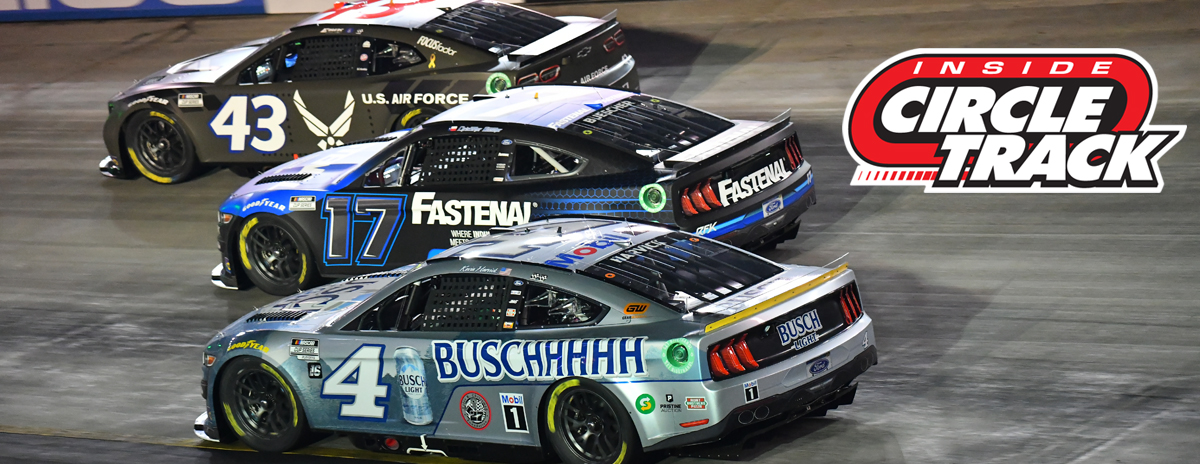Going into Sunday’s Folds of Honor QuikTrip 500 at the Atlanta Motor Speedway there were numerous questions that observers of the Monster Energy NASCAR Cup Series were hoping to have answered. With the race cars being fitted for the first time in competition with tapered spacers meant to reduce air and fuel flow to the engines and thus reduce horsepower, many wondered how the racing would be impacted on the track known for causing extreme tire wear due to its aged asphalt surface.
But instead of having that question fully answered, there were actually more questions raised during the running of the second race of the 2019 NASCAR schedule.
Below are some of the questions that either I myself had or that were asked on social media following the race. Please click on my Twitter link posted at the end of this piece or “Like” our Facebook page also linked below to offer your views on these topics:
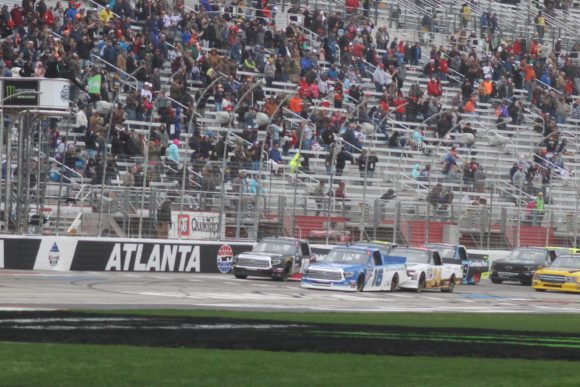
The NASCAR Gander Outdoors Truck Series race took the green flag with a light mist falling
Racing in the rain – To explain why I’m asking this question let me first explain that all throughout the day there was a mist falling at Atlanta Motor Speedway on Saturday during the NASCAR Xfinity Series race and the Gander Outdoors Truck Series event.
I have no idea how the television coverage portrayed it but there was definitely moisture in the air virtually all day. Xfinity and NGOTS qualifying were both canceled as a result. However, I was first of all surprised when NASCAR called for the MENCS cars to roll onto the track for their noon practice and I was almost as surprised that the teams actually sent the cars out.
So before saying anything else, I will give major props to NASCAR and AMS for keeping the track drying equipment on the speedway for the entire morning to keep the track surface dry which eventually allow for racing.
Now, here’s the question- Should NASCAR race in the rain?
My answer – There are not very many things I would be more opposed to than NASCAR racing in the rain. It’s just something I do not care to see. Believe me, as a lifelong fan of this sport and on more than a few occasions having my heart broken by a postponement as a kid hoping to see a race, I know the frustration of an event being put off until Monday because of weather. However, I don’t want to see cars tip-toeing around a race track as they slosh through puddles of water and spend more time trying to avoid spinning out than they do racing. If sports cars or Formula 1 want to race in the rain, let them. But as for me, I prefer dry pavement, even if it takes and extra day to get it.
Now again, Saturday’s events were not held under dangerous conditions but there was moisture in the air.
What are your thoughts?
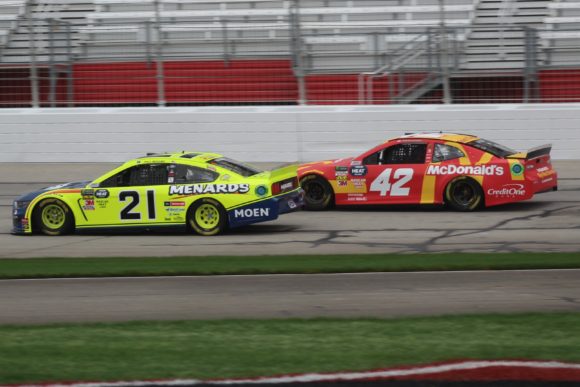
The tapered spacer was implemented to bring cars closer together
Horsepower robbing tapered spacers – During the 2018 season NASCAR announced an initiative that it hopes will create Talladega-style pack racing, or at least a tighter bunching of the field, on the tracks measuring 1.5 – 2 miles in length. The sanctioning body began the implementation of those changes in Atlanta. The tapered spacer is meant to take engines down to 550 horsepower from the 850-900hp they were making last season. Also, on most tracks over one mile in length there are to be aero ducts placed in the front of the cars and larger spoilers on the rear of the cars to increase drag. However, the Atlanta race did not feature the use of the aero ducts.
Now here’s the question- Did the tapered spacers actually work?
My answer – Well, the first and most obvious part of the answer is that yes, the spacers did take horsepower away from the cars. However, the racing at Atlanta Motor Speedway, with its worn surface, has always been about tire management and pit strategy more than about raw speed and horsepower. Ultimately, Brad Keselowski won the race on Sunday because he had the best tires and the best track position following the final pit stop.
I know this sounds like a cop out answer but it seems unfair to judge the “new package” before it is fully implemented. That said, there was no car that could have been easily labelled as the dominant machine in the race as several drivers took turns at the front of the field. And the lead cars of Keselowski and Martin Truex, Jr. were within a car length of each other at the checkered flag. So from those two standpoints, there was drama involved on a track that has seen one car lead huge chunks of the race in the past.
On the other side of things, as someone who attends numerous Dirt Late Model races each year, the cars raced somewhat like Crate Late Models in that no one had more horsepower than anyone else which can make it difficult to gain on, and ultimately pass, the other cars. Maintaining momentum seems to be everything and having to let off the gas when no one else does can seriously hamper a driver’s efforts. Having everyone running basically the same speed is not necessarily a good thing for racing. But again, let’s wait and see how everything plays out over a few races once the new package is fully implemented.
What are your thoughts?
Mid-week racing in Atlanta – I don’t think anyone would disagree that the February date given to the Atlanta Motor Speedway is not a favorable one for its lone NASCAR weekend. But a look at the MENCS schedule does not reveal very many holes in which to move that race date. New NASCAR president Steve Phelps has gone on record as stating that “everything is on the table” in terms of considering possible changes coming for the sport. One of those changes that has been mentioned is the possibility of mid-week races.
Now here’s the question- Would Atlanta be a prime candidate to host mid-week racing?
My answer– To me, this is a no-brainer. The date for the race at AMS has bounced all over the place with it at one time being the last event on the schedule, to Labor Day weekend, to its current place on the calendar. And with all that, the track in recent years has not had great attendance no matter which date it was given. Mid-week races would be made-for-television specials in all likelihood with practice, qualifying, and racing probably taking place on the same day and this track would be perfect for that.
The one major drawback to AMS hosting a mid-week race would be the fact that it would have to be run at night which would take away some of the slippery aspect of the racing surface but that has been lessened by racing in the coolness of February to a degree anyway.
I would say yes to giving AMS a mid-week date if that sort of scheduling ever comes to pass.
What are your thoughts?
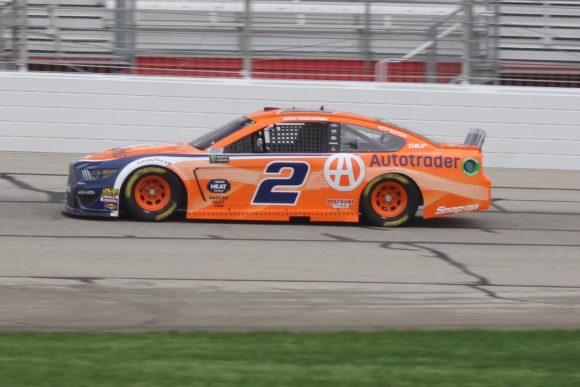
Brad Keselowski was in the right place at the right time
The late race restart fiasco – A caution flag waved on lap 274 of the 325-lap Folds of Honor QuikTrip 500 in Atlanta on Sunday. The problem with that was the fact that numerous cars had just completed or were in the process of making green flag pit stops at the time of the yellow flag. As a result, numerous cars were trapped one lap down with only three cars remaining on the lead lap.
This is where the confusion really began.
Whenever a caution flag waves in NASCAR, the highest running driver who is one or more laps down is designated as the so-called “lucky dog” and is allowed to pass the pace car and regain a lap. That car is then assigned to restart behind the last of the other lead lap cars. And more, when the lead lap cars pit, those who do not come down pit road are eligible for a “wave around” in which they are allowed to pass the pace car and make up a lap. By rule, the wave around cars must line up behind the lucky dog for the ensuing restart. So, even though he pitted an additional time during the caution, as he was allowed to do, Keselowski was designated as the lucky dog and restarted in the second row because there had only been three cars on the lead lap. All of the wave around drivers had to fill in behind him.
The wave around rule was instituted several years ago to keep the leaders from getting mired in traffic among those cars that did not pit under the caution. But in this case, there was confusion that resulted from the combination of the lucky dog and wave around rules being implemented at such a crucial juncture in the race. And to further add to the misunderstanding, Truex had initially been issued a penalty for his pit crew coming over the wall too soon that was later withdrawn by NASCAR as officials cited insufficient evidence of an infraction.
Now here’s the question- Does NASCAR really need the wave around rule?
My answer – This may be an unpopular opinion but I have never understood the need for the wave around rule. In my opinion, there ought to be some reward for those who have managed their strategy and put themselves in the position to gain from a caution such as happened here. At the same time, those who did get trapped would have ample opportunity to make up the full lap if they could stay in front of the leader and catch another caution. Being in traffic almost always makes the racing better whether it be on a short track or a big super speedway. I don’t see why the leader has to always be put out in front with clean air. I would do away with the wave around rule if it were up to me.
What are your thoughts?
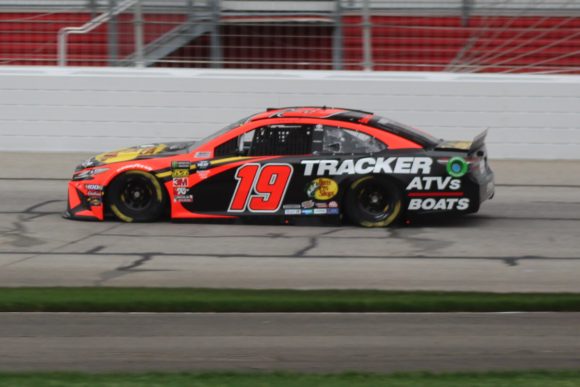
Martin Truex, Jr. vs Ricky Stenhouse, Jr. – In the closing laps of the Atlanta race, Brad Keselowski got out in front of the pack and built a relatively nice lead over his pursuers. At the same time, the lapped car of Ricky Stenhouse, Jr. found himself between Keselowski and second running Truex. Over his team radio Truex was furious with Stenhouse claiming that the lapped No. 17 was disturbing the air and that he should move out of the way.
After the race, Stenhouse countered by saying that Truex was not close enough to him for such action and when the No. 19 car finally got within 10 car lengths he did just that and moved out of the way. Truex’s Toyota eventually closed right to the rear bumper of Keselowski’s Ford but was never able to make the pass for the lead.
Now here’s the question – Should lapped cars always move out of the way of the leaders?
My answer – Ultimately, everyone out there is racing for themselves and not other teams. That was brought out at the end of the Daytona 500 when Michael McDowell remarked that his team does not pay him to push Joey Logano to the win after Logano complained that the Ford behind him should have drafted with him rather than a Toyota. So my answer is simply that it’s completely up to the driver in question as to what he wants to do in that situation. While it may be considered gentlemanly to let another car pass, it may not be in the best interest of the lapped driver’s team to do so. If they want to move over, then they can move over. If not, keep fighting but be prepared for criticism.
What are your thoughts?
Richard Allen is a member of the National Motorsports Press Association
Respond to this piece on Twitter –> @RichardAllenIDR
or on Facebook –> InsideCircleTrack/Facebook
